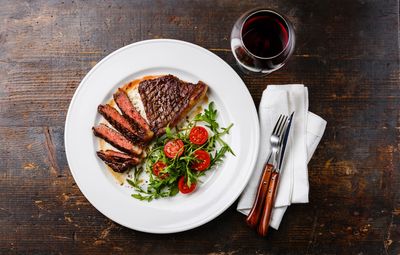Wine and food pairing is the art of matching a wine with a dish to enhance the flavors of both. Generally, pairing involves considering the intensity, acidity, sweetness, and other characteristics of the food and wine to create a harmonious experience. Here's a simple Pairing List to see what wines can be sure bets with popular dishes.
Key Principles of Wine and Food Pairing
- Match Intensity: Pair bold, flavorful dishes with full-bodied wines and lighter dishes with lighter-bodied wines.
- Acidity: High-acid foods (like vinaigrettes) pair well with high-acid wines, while fatty foods are balanced by high-acid wines.
- Sweetness: Sweet wines complement sweet dishes, and they can also help cool down the heat of spicy foods.
- Bitterness/Astringency: Fatty or sweet components in food can balance the bitterness or astringency of a wine.
- Umami: Dishes high in umami (found in ripe fruits, seafood, etc.) can be paired with fat or cream to help them pair better with wine.
- Consider the Sauce: The sauce often dictates the best wine pairing for a dish, rather than just the protein.
Tips for Beginners
- Start with the basics: Consider the flavor intensity and acidity of both the food and wine.
- Don't overthink it: Focus on the main components of the dish and the wine.
- Experiment and have fun: The best pairings are often found through experimentation.
Common Pairings
- Red Meat: Cabernet Sauvignon, Merlot, and Zinfandel are often paired with red meat.
- White Meat/Seafood: White wines like Sauvignon Blanc, Pinot Grigio, and Chardonnay pair well with white meat and seafood.
- Spicy Food: Sweet wines like Riesling or Gewürztraminer can help balance the heat.
- Sweet Desserts: Sweet wines (like dessert wines) are ideal with sweet desserts.
- Salty Foods: Sparkling wines and other high-acid wines pair well with salty foods.
- Earthy Flavors: Pinot Noir and other earthy wines pair well with dishes featuring earthy flavors like mushrooms.
Wines That Don't Pair Well
Certain foods and wines just don't create a harmonious pairing. For example, avoid pairing a light-bodied rosé with a hearty steak, as the wine's delicate flavors will be overpowered. Similarly, spicy dishes are often a poor match for high-alcohol wines, as the alcohol can intensify the heat. Other challenging pairings include artichokes with any wine, and sushi with most wines due to their unique flavor profiles.
- Rosé and Steak: Rosé's refreshing, light character is overwhelmed by the richness and savory flavors of a steak. It's best to pair steak with a bold red wine like Cabernet Sauvignon or Malbec.
- Spicy Foods and High-Alcohol Wines: The capsaicin in spicy foods intensifies the perception of alcohol in wine, making it taste harsher and more bitter. Opt for low-alcohol, slightly sweet wines like Moscato or off-dry Riesling.
- Artichokes and Most Wines: Artichokes contain cynarin, an enzyme that can make wine taste metallic and unpleasant.
- Sushi and Most Wines: The delicate flavors of sushi are easily overpowered by the tannins and acidity of many wines.
- High-Acid Foods and Low-Acid Wines: Foods with high acidity, like citrus, tomatoes, or vinegar-based dressings, can make dry wines taste tart and unpleasantly acidic.
- Chocolate and Most Wines: The richness and sweetness of chocolate can clash with many wines, especially dry reds. Consider a dessert wine like Port or a late-harvest wine with chocolate.
PAIRING HISTORY
The history of pairing food and wine goes back centuries, evolving from necessity to a sophisticated culinary practice. Initially, wine was a safer alternative to water, and pairings were often based on regional availability. Over time, culinary traditions developed alongside winemaking, leading to classic pairings like red wine with lamb in regions where both were prominent. Modern food and wine pairing, with its emphasis on specific flavor combinations, is a relatively recent development, influenced by the rise of sommeliers and the availability of diverse wines and cuisine.
Early History
- Ancient Times: Wine was a staple due to its safety compared to local water sources.
- Regional Development: Cuisine and winemaking evolved together, with local wines naturally complementing local dishes.
- Classic Examples: Red wine with lamb, a staple in many European regions, became a classic pairing.
Middle Ages
- Monasteries: Monasteries played a role in brewing and the development of pairings, especially with spiced wines.
- Trade and Spice: Trade routes brought new ingredients, like spices, leading to new pairings.
Modern Era
- 19th Century: The rise of sequential dining (e.g., white wine with fish, red wine with meat) influenced pairing practices.
- 20th Century: The development of modern food and wine pairing as a culinary art form, including the rise of sommeliers.
- Today: Food and wine pairing is a science, with online and print resources providing guidance, but also recognizing individual preferences and situational contexts.
For those studying or want to know what the WSET courses cover... here you go. This is what you can expect to learn.
